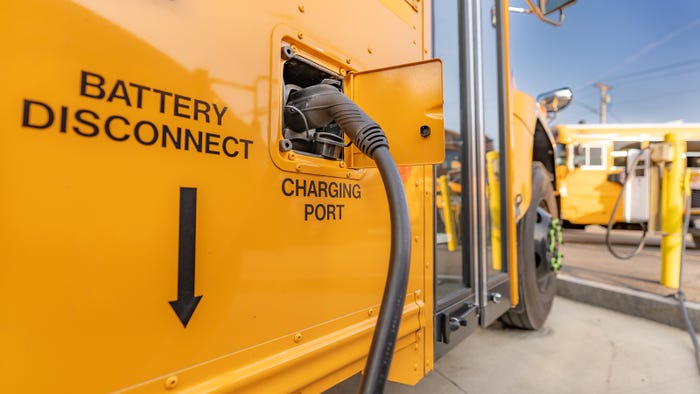Could EVs and Homes Become the Guardians of the Grid?
A look at the logistics of using electric-vehicle and home batteries to stabilize the grid.

As societies strive to reduce their reliance on finite resources like gas and transition towards more sustainable energy alternatives, the electricity grid has assumed a pivotal role in facilitating this transition. The increasing electricity demand, driven by factors such as the electrification of transportation and the growing prevalence of renewable energy sources, has placed unprecedented pressure on the grid. Electric transportation and housing that use a big-capacity battery and have a strong system could serve a dual purpose beyond their primary powering function by acting as energy storage units. Considering the benefits this process would bring as well as its limitations, the question is: Could electric school buses, entire houses, and EVs contribute to a healthier grid solution?
Giving more power to the grid
In the pursuit of a more sustainable and interconnected energy landscape, connecting individual elements to the grid when not in use can alleviate the pressure on the grid when it’s in high demand. One way this could be accomplished is through electric school buses. Indeed, in the United States, school buses are the largest form of public transportation with 480,000 of them carrying up to half of the country’s children to school and back. However, fewer than 1% of these are currently powered by electricity. As school buses tend to be idle for up to 18 hours a day during the school year in addition to almost three months during the summer, they can be used as small and mobile sources of power through their battery. Consequently, making school buses electric can bring many benefits including relieving the grid, a more sustainable and clean environment, and cost savings.

Electric school bus plugged in at a charging station. Credit: TW Farlow / iStock - Getty Images Plus via Getty Images
The benefits of an interconnected grid
Relieving the grid: One of the main reasons for connecting strong battery storage units to the grid is to strategically release power to address peak demand surges. Indeed, any suitably equipped EV with the appropriate equipment can serve as a means to store excess electricity, eliminating the necessity for utilities to activate gas-powered power plants during periods of insufficient sunlight or wind. School buses, in particular, prove highly effective for this purpose due to their sizable batteries, extended periods of parking throughout the day, and availability during the summer’s high temperatures. As a result, this could stabilize the electric grid and provide surges of electricity precisely when the grid requires it.
A cleaner environment: As more homes turn towards EVs and solar panels, greener choices are being made at the same time as the amount of power stored per home is increasing. This contributes to a more sustainable environment as the reliance on traditional sources of power is reduced. When looking at electric school buses, if half of the US’s fleet transitioned from diesel to electric, an annual reduction of approximately 2.1 million tons of CO2 could be achieved, even when factoring in emissions from electricity generation.
Similarly, the substitution of every school bus currently operational in the United States with an electric version could result in an additional 60 GWh to the country’s electricity storage capacity. These numbers could continue to grow if smaller EVs, such as cars, also served this function. At the same time, replacing all diesel-powered school buses with electric models would lead to a substantial decrease in greenhouse gas emissions, preventing approximately 8 million metric tons of emissions annually. For example, in a city that had around 400 school buses, if half of them switched to electric, it would reduce CO2 emissions by approximately 1,700 tons per year. Furthermore, by eliminating pollution from combustion-engine buses this can reduce asthma and other diseases in children.
Current limitations
While there are many benefits to using electric-powered transportation and homes to alleviate the grid, limitations around the current setup and cost must also be considered.
Infrastructure, regulations, and technology: Some of the main challenges lie in infrastructure, logistics, and technology. Firstly, the question arises about the responsibility and compensation when individuals with electronic homes supply excess energy to the grid. Determining whether the grid or the neighbor pays, along with navigating relevant regulations, adds a layer of complexity.
Secondly, the technology powering EVs, particularly their batteries, is not yet evolved enough to seamlessly connect to the grid and supply electricity during times of fluctuation or increased demand.
Finally, the need for infrastructure development to facilitate the connection of these homes and EVs to the grid poses a significant hurdle. This involves planning where such infrastructure will be implemented and finding solutions to adapt older homes to accommodate these advancements. Addressing these challenges is crucial for realizing the full potential of electric homes and vehicles as effective battery storage solutions.
The cost of the setup: In addition to the logistics behind setting this infrastructure up, cost also remains a big hurdle. Indeed, in the current landscape, EV insurance costs more compared to ICE vehicles. Moreover, an electric school bus alone can cost three times as much as a $100,000 diesel bus, and while a standard EV charger adapted to buses can cost from $3,000 to $7,000 to install, it’s estimated that the equipment needed to transmit power back to the grid ranges from $10,000 to $58,000.
During this transition period, navigating complex financial hurdles is a crucial task. Across various states in the US, an additional challenge lies in defining fair compensation models for individuals and businesses contributing power to the electric grid.
Alleviating the grid
Even with the infrastructure and regulations are in place, at present the costs associated with switching to electric wouldn’t be worth it to EV and homeowners. The solution to achieving this change is through improved battery technology, which in the long run would be more beneficial for those involved in providing power to the grid.
Additionally, when it comes to EVs, one of the initial hurdles lies in overcoming psychological barriers, such as range anxiety, to pave the way for the realization of a bigger vision: seamless integration with the grid. While this concept is within reach with the right technology and mindset, its feasibility relies on batteries with robust life cycles. Indeed, if a battery fails after just 3,000 cycles, the equivalent of approximately 7 years in an EV, the incentive to connect it to the grid diminishes. Addressing these concerns, from extending battery lifetime in extreme temperatures will be crucial for relieving the grid during the coldest winters and the hottest summers.
About the Author(s)
You May Also Like





